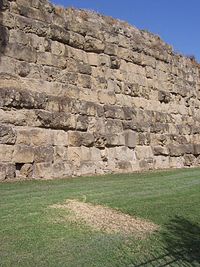Servian Walls
| Servian Wall | |
|---|---|
| Rome, Italy | |

A preserved section of Servian Wall next to Termini railway station.
|
|

A map of Rome showing the Servian Wall (blue) and its gates. The Aurelian Walls (red) were constructed in the 3rd century AD.
|
|
| Type | Defensive wall |
| Height | Up to 10 metres (33 ft) |
| Site information | |
| Open to the public |
Open to public. |
| Condition | Ruinous. Fragmentary remains |
| Site history | |
| Built | 4th century BC |
| Materials | Tuff |
| Events | Second Punic War |
| Garrison information | |
| Occupants | Romans |
The Servian Wall (Latin: Murus Servii Tullii; Italian: Mura Serviane) was an ancient Roman defensive barrier constructed around the city of Rome in the early 4th century BC. The wall was up to 10 metres (32.8 ft) in height in places, 3.6 metres (12 ft) wide at its base, 11 km (7 mi) long, and is believed to have had 16 main gates, though many of these are mentioned only from writings, with no other known remains.
It is presumed that the wall is named after the sixth Roman King, Servius Tullius. Although its outline may go back to the 6th century BC, the currently extant wall was, it is estimated, built during the early Roman Republic, possibly as a way to prevent a repeat of the sack of Rome after the Battle of the Allia by the Gauls of Brennus. Due to the ease with which the Gauls entered the city, it is conjectured that at some time previous to this, Rome had been forced by its Etruscan rulers to dismantle any significant prior defenses.
The wall was built from large blocks of tuff (a volcanic rock made from ash and rock fragments ejected during an eruption) quarried from the Grotta Oscura quarry near Rome's early rival Veii. In addition to the blocks, some sections of the structure incorporated a deep fossa, or ditch in front of it, as a means to effectively heighten the wall during attack from invaders.
Along part of its topographically weaker northern perimeter was an agger, a defensive ramp of earth heaped up to the wall along the inside. This thickened the wall, and also gave defenders a base to stand while repelling any attack. The wall was also outfitted with defensive war engines, including catapults.
The Servian Wall was formidable enough to repel Hannibal during the Second Punic War. Hannibal famously invaded Italy across the Alps with elephants, and had crushed several Roman armies in the early stages of the war. However, the wall was never put to the test as Hannibal only once, in 211 BC, brought his Carthaginian army to Rome as part of a feint to draw the Roman army from Capua. When it was clear that this had failed, he turned away, without approaching closer than 3 miles (5 km) to Rome, as a Roman army sallied out of the Servian walls and pitched a camp next to Hannibal's. During the Roman civil wars, the Servian walls were repeatedly overrun.
...
Wikipedia
